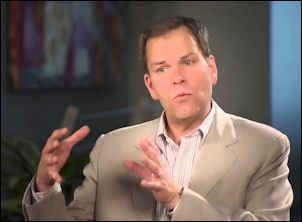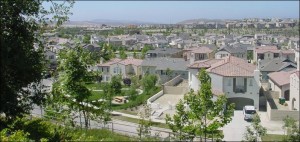A California developer is teaming with Daimler AG to bring buses, shuttles and ride sharing to an Orange County community — with no government subsidies.
by James A. Bacon
Rancho Mission Viejo south of Los Angeles is developing a 23,000-acre planned development with all the amenities one would expect from an affluent California community: parks, hiking/biking trails, yoga and fitness studios, community gardens and a hacienda-style clubhouse. But the biggest selling proposition may be the potential to slash living expenses by thousands of dollars yearly by living a car-lite lifestyle.
Working in partnership with Daimler AG’s Business Innovation group, Rancho Mission Viejo will introduce to its Ladera Ranch community in July a service that provides residents access to scooters, cars, circulator buses, destination shuttles, Car2Share carpooling and other bundled transportation services, all accessible through a smartphone app. Those services will be provided as well to the neighboring Sendero project, with an expected 14,000 new residents and workers in five million square feet of commercial space, now under development.
David Grannis, a partner with pointC Partners, who is leading the initiative for the developer, says the goal is to cut the cost of mobility in half from the $14,000 or more it takes to own and operate an automobile today in south Orange County, California. Households in the target demographic typically own two or three cars. “I’m not telling you to get out of your car,” he told attendees of the 2014 LOCUS conference in Washington, D.C., earlier this month. “I’m telling you to get out of your third car.”
If successful, the transportation-as-a-subscriber-service initiative could transform the economics of automobile transportation. Daimler, parent company of Mercedes Benz, could evolve from a company that primarily manufactures and sells automobiles into a company that provides mobility services. Other auto companies that are exploring similar strategies could follow suit. The new business model could slash the cost of mobility for Americans, improving their standard of living, while shifting people out of single-occupancy automobiles into buses, vans and other shared-ridership modes, thus burning less gasoline and releasing less greenhouse gas.
Experience has shown that moral suasion — it’s good for the environment — doesn’t work very well, Grannis says. When Rancho Mission Viejo offered the option of environmentally beneficial solar roofs or granite counter tops, 97% of buyers selected the granite counter tops — until the recession came along and people appreciated the fact that photovoltaic roofs could reduce their energy bills. He sees the mobility service the same way. A handful of people will go for it because it’s the right thing to do; the rest will embrace it because it saves them thousands of dollars per year. “It’s economics, all economics.”
Rancho Mission Viejo’s multimillion-dollar experiment, says Grannis, responds to confluence of environmental, regulatory and demographic trends.
On the regulatory front, California has mandated massive cuts in greenhouse gas emissions, which will require major shifts in transportation habits and development patterns. It is all but illegal to continue building the kind of low-density suburban communities associated with heavy automobile use and high GHG emissions. At present, 80% of Ladera Ranch residents drive alone to work, most of them to destinations outside the community. None of them bicycle or ride transit to work. To meet regulatory goals, the developer has to find a way to reduce the solo commute.
Another trend is demographic. Rancho Mission Viejo is focused mainly on Baby Boomers and Millennials. Boomers are selling the houses they lived in when raising families. As they age and find it more difficult to drive, Boomers are concerned about losing their mobility. They also see walkability as a fitness imperative. They want communities where they can get around on foot. Buses, vans, bikes and scooters complement walkable neighborhoods very nicely. Meanwhile, Millennials are less enamored with car ownership than previous generations. If they can find a less expensive mode of transportation, they will gladly take it.
People still want to live in well-designed communities such as Rancho Mission Viejo where they enjoy access to good schools, open space and lots of healthy activities, says Grannis. Automobile ownership is superfluous. What matters is mobility and access. And that’s what the venture with Daimler will provide them.
Transportation-as-a-service represents the next great evolution of the automobile industry. Grannis equates the innovation in importance to Henry Ford’s assembly line that introduced cheap cars and to the financing revolutions that made it easier for people to buy and lease cars. The next big step will be to eliminate much of the cost and risk associated with auto ownership.
A necessary prerequisite for making transportation-as-a-service work is to design walkable communities. Rancho Mission Viejo is planning compact residential neighborhoods with sidewalks and commercial districts with complete streets. The next step is pitching the service to a population not accustomed to it by making it as easy as consulting your smart phone to reserve a ride, and by providing incentives, offering rewards and making it fun. Phase 1 will provide a rideshare program for commuters — “ride everyday or ride when you want… in a Mercedes” — as well as a ranch circulator carrying residents to most popular locations. The ride-share will require people to sign up and reserve a seat. The circulator will run a less-than-bus-sized vehicle along regular routes to key destinations and is expected to evolve into a service that allows residents to flag the bus “anywhere, anytime” with their smart phones. The app will connect passengers in the same area who want to reach the same destination, using public objects such as libraries and pocket parks as gathering points.
A second phase will locate Mercedes cars and scooters throughout Ladera and at employment centers where Laderians work, and make them available for short-term use. All vehicles will run on clean energy drive train.
Grannis is not yet prepared to discuss key details of the proposal, such as how the subscription service will work for existing homeowners. Will participation be voluntary? Will the service be bundled into homeowner association dues? What will be the monthly charge? But he does say he expects the program to cut individual annual transportation costs roughly in half. And, if the pilot program works in Ladera, Rancho Mission Viejo will pitch the service to home buyers in its new Sendero development. “Buy a home, get Mercedes Mobility services.”
This may be one of the most important transportation experiments taking place in the United States today. Rancho Mission Viejo and Daimler Business Innovations will have to support the program financially for before the program reaches break even. But neither the developer nor the automaker would have embarked upon the venture if they didn’t think it would make money eventually. If transportation-as-a-service can be shown to be profitable, it will be a game changer. Every big developer and every big auto manufacturer in the country will begin replicating the model everywhere they can and modifying it where they can’t. Transportation will never be the same.




